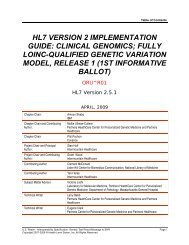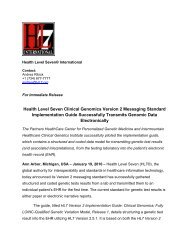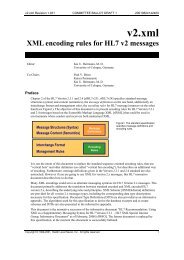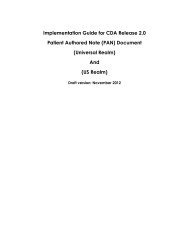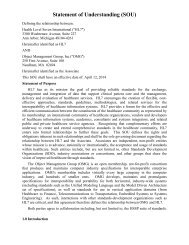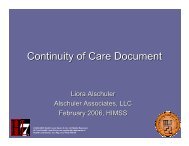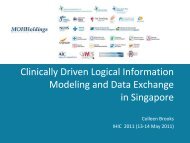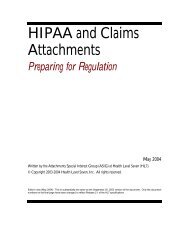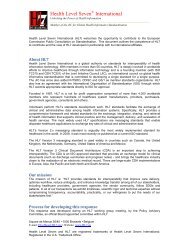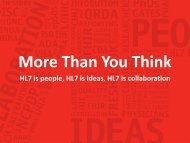HL7 CDA R2 AIS Implementation Guide
HL7 CDA R2 AIS Implementation Guide
HL7 CDA R2 AIS Implementation Guide
Create successful ePaper yourself
Turn your PDF publications into a flip-book with our unique Google optimized e-Paper software.
<strong>HL7</strong> Additional Information Specification <strong>Implementation</strong> <strong>Guide</strong><strong>CDA</strong><strong>R2</strong><strong>AIS</strong>0000R030An OID is a globally unique string consisting of numbers and dots (e.g.,2.16.840.1.113883.6.103). This string expresses a tree data structure, with the left-most numberrepresenting the root and the right-most number representing a leaf.Each branch under the root corresponds to an assigning authority. Each of these assigningauthorities may, in turn, designate its own set of assigning authorities that work under itsauspices, and so on down the line. Eventually, one of these authorities assigns a unique (to it asan assigning authority) number that corresponds to a leaf node on the tree. The leaf may representan assigning authority (in which case the @S attribute identifies the authority), or an instance ofan object. An assigning authority owns a namespace, consisting of its sub-tree.<strong>HL7</strong> is an assigning authority, and has the OID prefix "2.16.840.1.113883." Any OID that beginswith this is further described by a registry maintained by the <strong>HL7</strong> organization. For example, theOID 2.16.840.1.113883.6.103 (above) was established by <strong>HL7</strong> as a globally unique identifier forthe ICD-9-CM code set for diagnoses 7 .The numbers in the <strong>HL7</strong> OID indicate that:• The OID was assigned by a joint ISO-ITU (2.) assigning authority,• it is specific to the country (16.)• of the USA (840.)• and is specific to the organization (1.)• known as Health Level Seven (113883.).Beyond that, the <strong>HL7</strong> organization assigns any numbers - and these are maintained in a registryavailable on the <strong>HL7</strong>.org website. <strong>HL7</strong> uses its registry to assign OIDs within its branch for <strong>HL7</strong>users and vendors upon their request. <strong>HL7</strong> is also assigning OIDs to public identifier-assigningauthorities both U.S. nationally (e.g., the U.S. State driver license bureaus, U.S. Social SecurityAdministration, US National Provider Identifier (NPI) registry, etc.) and internationally (e.g.,other countries' social security administrations, citizen ID registries, etc.)Additional reference information about OIDs, including the current directory of OIDs assigned by<strong>HL7</strong>, is available at http://www.hl7.org/oid/index.cfm. Organizations that wish to request anOID for their own use (e.g., to be able to create identifiers within a <strong>CDA</strong> document), may alsoobtain one from <strong>HL7</strong> at this site.2.5.6.1 Placeholder OIDs(New section) Add discussion similar to what is in the Ballot ReadMe file, geared towardsimplementers [Conny-21] mention <strong>AIS</strong> specification documents and example files.2.6 Rules for Constructing Attachment DocumentsAll attachment documents are <strong>HL7</strong> <strong>CDA</strong> documents. Attachment-specific Additional InformationSpecifications specify the content for all attachments, additionally; they specify the code(s) to beused for the computer-decision variants.7 The <strong>HL7</strong> Vocabulary TC retired 2.16.840.1.113883.6.2 in 2004 in favor of two separate code sets, one for ICD-9-CM diagnoses, and another for ICD-9-CM Procedures.Copyright © 1998-2007 Health Level Seven, Inc. All rights reserved.Release 3.0 Draft StandardPage 27March 2007




